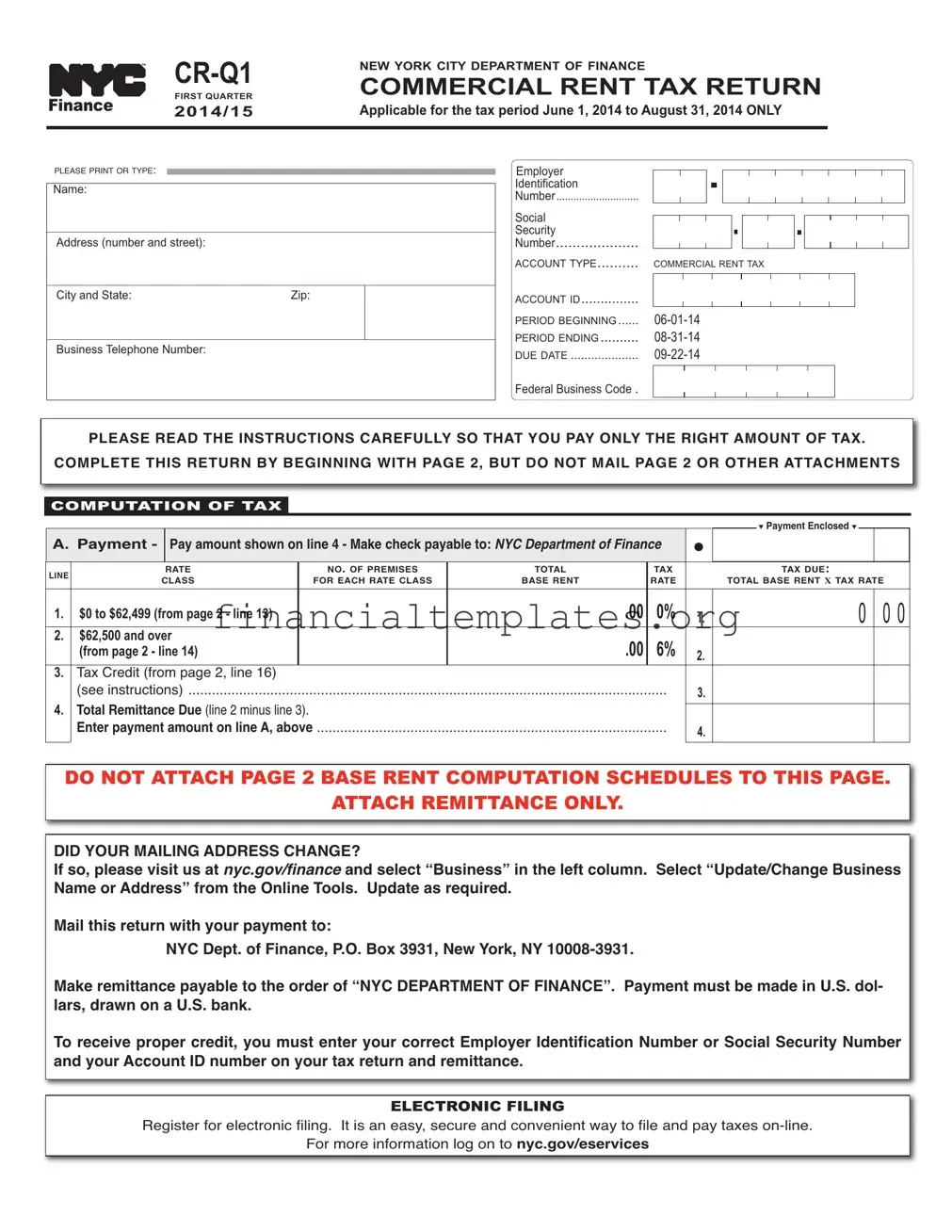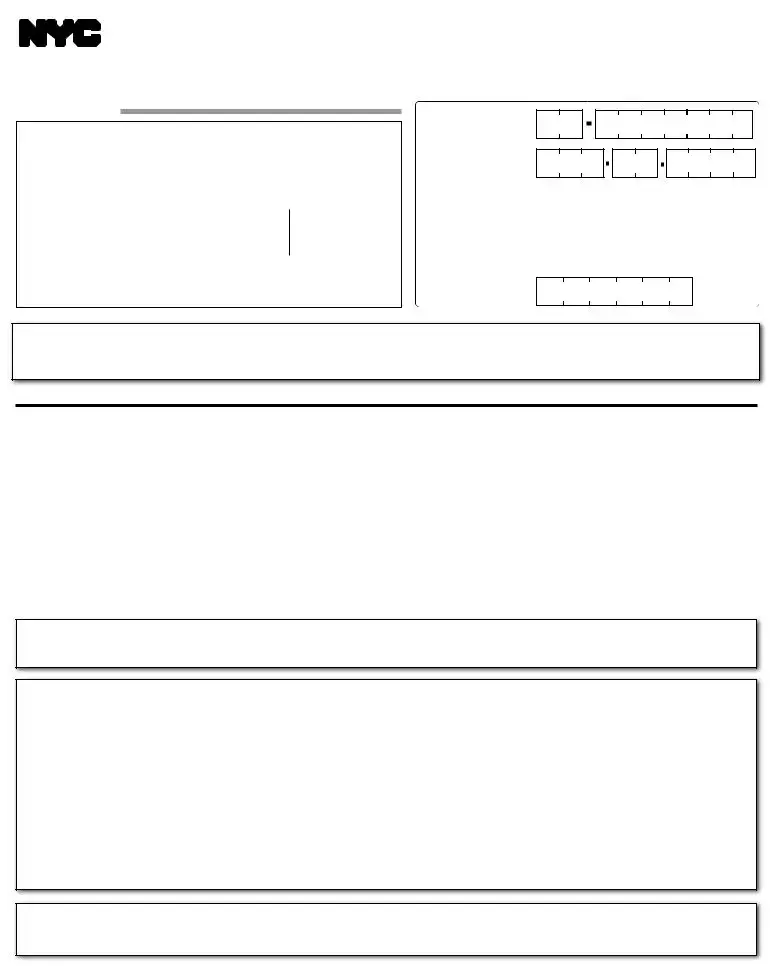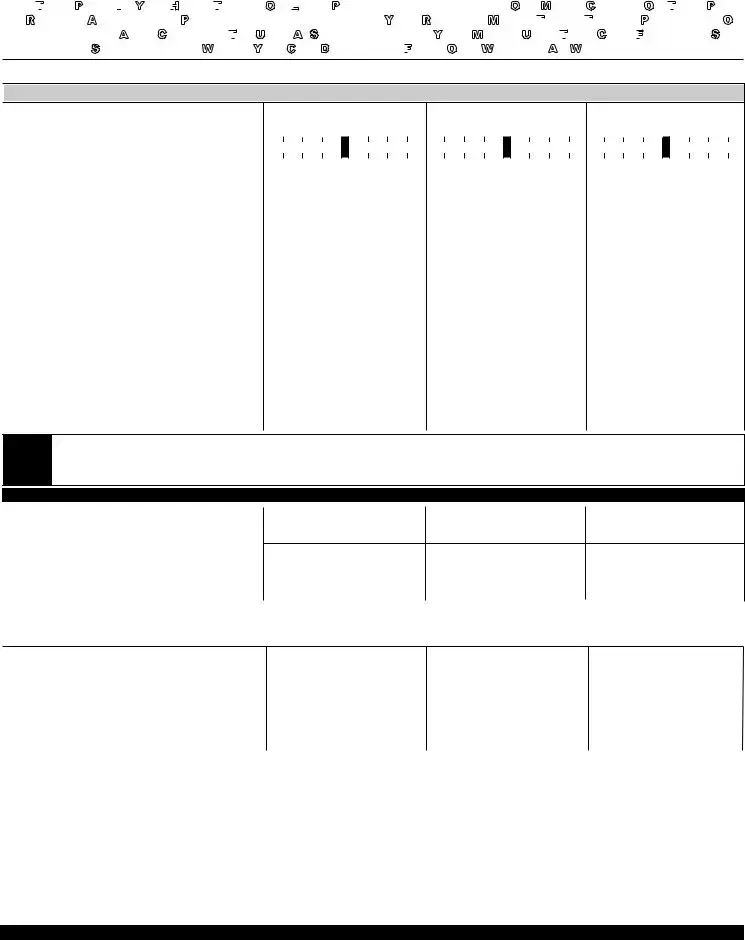Form CR-Q1 for the tax period June 1, 2014 toAugust 31, 2014 ONLY |
Page 2 |
USE THIS

 PAGE IF
PAGE IF YOU HAVE
YOU HAVE
 THREE
THREE

 OR LESS
OR LESS
 PREMISES/SUBTENANTS OR, MAKE COPIES OF THIS
PREMISES/SUBTENANTS OR, MAKE COPIES OF THIS

 PAGE TO REPORT ADDITIONAL PREMISES/SUBTENANTS. IF YOU REPORT MORE THAN
PAGE TO REPORT ADDITIONAL PREMISES/SUBTENANTS. IF YOU REPORT MORE THAN

 THREE
THREE

 PREMISES OR SUBTENANTS, AND CHOOSE TO
PREMISES OR SUBTENANTS, AND CHOOSE TO

 USE A SPREADSHEET, YOU MUST USE THE
USE A SPREADSHEET, YOU MUST USE THE

 CRQ FINANCE
CRQ FINANCE
 SUP- PLEMENTAL SPREADSHEET, WHICH YOU CAN DOWNLOAD FROM
SUP- PLEMENTAL SPREADSHEET, WHICH YOU CAN DOWNLOAD FROM
 OUR WEBSITE AT WWW.NYC.GOV/CRTINFO.
OUR WEBSITE AT WWW.NYC.GOV/CRTINFO.
EACH LINE MUST BEACCURATELYCOMPLETED. YOUR DEDUCTION WILLBE DISALLOWED IF INACCURATE INFORMATION IS SUBMITTED.
LINE |
DESCRIPTION |
PREMISES 1 |
PREMISES 2 |
PREMISES 3 |
● 1a. |
Street Address ......................................................... 1a. |
|
|
|
|
|
|
1b. Zip Code ..................................................................1b. |
________________________________________________________________________________________ |
1c. |
Block and 1d. Lot Number...................................1c/1d. ________________________________________________________________________________________ |
|
|
|
1c. BLOCK |
1d. LOT |
1c. BLOCK |
1d. LOT |
1c. BLOCK |
1d. LOT |
● 2. |
Gross Rent Paid (see instructions) |
2. |
________________________________________________________________________________________ |
3. |
Rent Applied to Residential Use |
3. |
________________________________________________________________________________________ |
|
............................................. |
4a. |
________________________________________________________________________________________ |
●4b. Employer Identification Number (EIN) forKEEP THIS PAGE partnerships or corporations .....................................4b. ● 4b. EIN _____________________ ● 4b. EIN_____________________ ● 4b. EIN ____________________4a. SUBTENANT'S NAME
4c. Social Security Number for individuals |
4c. |
● 4c. SSN_____________________ ● 4c. SSN ____________________ ● 4c. SSN ____________________ |
4d. RENT RECEIVED FROM SUBTENANT |
|
|
|
(see instructions if more than one subtenant) |
4d. ___________________________________________________________________________________________________ |
5b. |
Commercial RevitalizationFORProgram |
YOUR RECORDS. |
5a. |
Other Deductions (attach schedule) |
5a. |
________________________________________________________________________________________ |
|
special reduction (see instructions) |
5b. |
________________________________________________________________________________________ |
6. |
Total Deductions (add lines 3, 4d, 5a and 5b) |
6. |
________________________________________________________________________________________ |
7.Base Rent Before Rent Reduction (line 2 minus line 6) ....7DO. ________________________________________________________________________________________NOT FILE
8.35% Rent Reduction (35% X line 7) ...........................8. ________________________________________________________________________________________
9. Base Rent Subject to Tax (line 7 minus line 8) ...........9. ________________________________________________________________________________________
If the line 7 amount represents rent for less than the full 3 month period, proceed to line 10a, or
NOTE If the line 7 amount plus the line 5b amount is $62,499 or less and represents rent for a full 3 month period, transfer line 9 to line 13, or If the line 7 amount plus the line 5b amount is $62,500 or more and represents rent for a full 3 month period, transfer line 9 to line 14
COMPLETE LINES 10 - 12 ONLY IF YOU RENTED PREMISES FOR LESS THAN THE FULL THREE-MONTH PERIOD
........10a. Number of Months at Premises during the tax period |
10a. # of months |
10b. From: |
10a. # of months |
10b. From: |
10a. # of months |
10b. From: |
|
|
10c. To: |
|
10c. To: |
|
|
10c. To: |
11.Monthly Base Rent before rent reduction
(line 7 plus line 5b divided by line 10a) |
11. ________________________________________________________________________________________ |
12.Quarterly Base Rent before rent reduction
(line 11 X 3 months) |
12. ________________________________________________________________________________________ |
■If the line 12 amount is $62,499 or less, transfer the line 9 amount (NOT THE LINE 12AMOUNT) to line 13
■If the line 12 amount is $62,500 or more, transfer the line 9 amount (NOT THE LINE 12AMOUNT) to line 14
|
RATE CLASS |
TAX RATE |
|
|
|
13. |
($0 - 62,499) |
0% |
13. |
_______________________________________________________________________________________ |
14. |
($62,500 or more) |
6% |
14. |
_______________________________________________________________________________________ |
15.Tax Due before credit
(line 14 multiplied by 6%) |
15. |
|
16. Tax Credit (see worksheet below) |
16. |
_______________________________________________________________________________________ |
Note: The tax credit only applies if line 7 plus line 5b (or line 12, if applicable) is at least $62,500, but is less than $75,000. All others enter zero.
Tax Credit Computation Worksheet
■If the line 7 amount represents rent for the full 3 month period, your credit is calculated as follows:
Amount on line 15 X ($75,000 minus the sum of lines 7 and 5b) = _____________ = your credit
$12,500
■If the line 7 amount represents rent for less than the full 3 month period, your credit is calculated as follows:
Amount on line 15 X ($75,000$12,500minus line 12) = _____________ = your credit
TRANSFER THE AMOUNTS FROM LINES 13, 14 AND 16 TO THE CORRESPONDING LINES ON PAGE 1





 PAGE IF
PAGE IF YOU HAVE
YOU HAVE
 THREE
THREE

 OR LESS
OR LESS
 PREMISES/SUBTENANTS OR, MAKE COPIES OF THIS
PREMISES/SUBTENANTS OR, MAKE COPIES OF THIS

 PAGE TO REPORT ADDITIONAL PREMISES/SUBTENANTS. IF YOU REPORT MORE THAN
PAGE TO REPORT ADDITIONAL PREMISES/SUBTENANTS. IF YOU REPORT MORE THAN

 THREE
THREE

 PREMISES OR SUBTENANTS, AND CHOOSE TO
PREMISES OR SUBTENANTS, AND CHOOSE TO

 USE A SPREADSHEET, YOU MUST USE THE
USE A SPREADSHEET, YOU MUST USE THE

 CRQ FINANCE
CRQ FINANCE
 SUP- PLEMENTAL SPREADSHEET, WHICH YOU CAN DOWNLOAD FROM
SUP- PLEMENTAL SPREADSHEET, WHICH YOU CAN DOWNLOAD FROM
 OUR WEBSITE AT WWW.NYC.GOV/CRTINFO.
OUR WEBSITE AT WWW.NYC.GOV/CRTINFO.